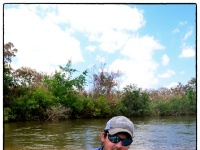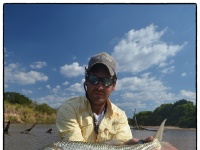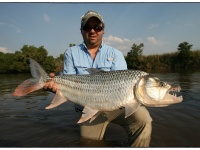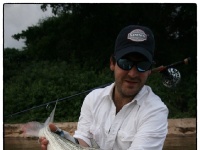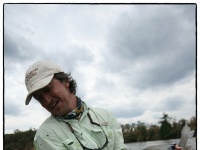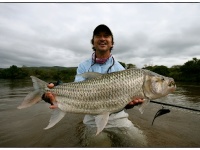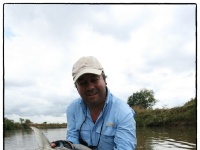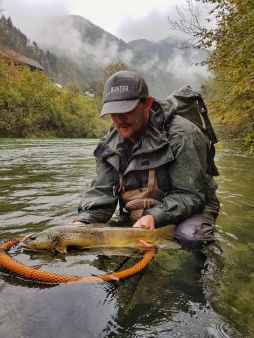The first time I met tigerfish was during a trip with my father to the lower Zambezi area. It was a fantastic experience, with plenty of ferocious strikes and elephants walking by our tents at night.
Africa is a different world, much different to what I imagined it would be; with wild animals to seriously respect all over.
During that first visit to Africa and its tigerfish we caught plenty, but it was not the right place to catch the big ones. The Zambezi River, in spite of having registers of tigers of over 30 lb, has been damaged and threatened by local fishermen with its nets. But that first trip really triggered me to search for the big monsters.
Tigerfish had always been in my wish list, mainly because of their resemblance with golden dorados, one of my favorite species.
As soon as we got back to Buenos Aires, I began a quest to find the spot of the big ones, mailing everyone who could help me out. Thanks to some guys I knew when I guided them; I got in touch with the perfect fishing operation in the heart of Tanzania.
A couple more phone calls and I had some company for the trip. I´ve shared many crazy moments in the Bolivian jungle with Claudio and Mauricio. They certainly were the right guys for this adventure. They are two of the most hardcore anglers I´ve been lucky to fish with in unforgettable fishing days.
We didn’t really know what to expect or what we were getting into but that didn’t matter much, the thought of a giant tigerfish outstood any possible fear.
My previous visit to Zambezi had showed me the power and strength of tigers; they take the fly and head in any possible direction in a way that resembles a missile. We set up heavy gear with beasts in our minds, several #8 to #10 rods and all kinds of tropical lines. There are no piranhas or similar fish to damage the lines in these rivers but there are submerged tress that have been tear down by elephants and heavy storms from the rainy season.
We tied the recommended flies and thought these looked small, so we included several big golden dorado flies and Titanics. Flies that surely no tigerfish had ever seen swimming by.
My father´s fly boxes are like Ali Baba´s cave, a really good place to go if you´re looking for something. I always end up tying some for him or making a deal in exchange.
The flight to Africa is not a problem. No more than 9 hours to Johannesburg and then another flight straight to Dar es Salaam, the most populated city of Tanzania, located on the shores of the Indian Ocean. We spent the first night at the Sea Cliff hotel, in the Msaki peninsula, right over the sea cliffs with an amazing view. It was an ideal place to enjoy our first African sunset, while having cold African beer.
One can find very nice craftsmanship close to the hotel, but pretty expensive compared to those in Zambia. I didn’t want to go back home carrying 100 pounds of wooden animals this time, so I relaxed and just got a few things that went straight to the bottom of the duffel bag.
I don´t know how we managed to get out of bed early to find the Caravan that would take us to the first camp. The flight was about an hour, all this time watching the beautiful Savannah's, forests and small villages.
The grass air track seemed just fine until we reached the ground and started shaking. We´ve had plenty of suicidal landings in Bolivia, so it was nice to rely on the Caravan and handle the rough patches with no problems.
The guides were waiting for us in the typical safari Toyota Land Cruisers, great vehicles for these kinds of roads. We drove for about twenty minutes until we reached the main lodge on the Mnyera river. The staff of the lodge welcomed us with drinks and singing African melodies that really transmit an enormous joy.
Rob, the lodge manager, gave us a speech about what to do regarding wild animals. He told us how the week was going to be and a bit about tigerfish. Then, we had lunch and jumped straight into the boats with our gear. I was once again about to begin an African safari with a rod in my hand.
Claudio and Mauricio went downstream and I headed upstream.
The scenery was amazing and animal encounters were constant. We heard the elephants but couldn’t see them until they decided to cross the river, shaking its ears and horn to us.
If I had to describe the Mnyera River I´d say it looks like Northern Patagonia rivers, with cliffs, sand banks, riffles, deep channels and lots of different water structure.
We made our first casts towards cliffs and logs and got our first strike. A strong, solid take followed by a long run, with a beastly strength that defied any logic. One must control the line and start working with the reel as fast as possible in order to control a big tiger that heads to the structure every time. Once hooked, one can´t give the fish any slack; if the line loses tension, you’ll lose the fish.
Tigerfish jaws are incredible, it´s not easy to set the hook correctly between those huge teeth. Many fish are lost because the fly gets stuck in between the teeth instead of being hooked in the flesh. Big tigers require using quality hooks and wire, because they cut them as razors.
The first evening was a warm up. We weren’t expecting a monster fish but Claudio caught a huge one on the final cast. The fish was about 20 pounds and Claudio was crazy about it. It really encouraged the whole group as well.
Africa is one of the least explored fishing destinations; this is due to the sociopolitical instability of its countries and also because of the hard access to its remote waters. This is why sanctuaries like these stay protected from civilization and agriculture that endanger the planet´s last virgin spots.
The safari industry in Africa has preserved many areas by forbidding hunting and illegal fishing. Sports’ fishing has recently gained importance and guides say that very few fly fishermen have fished at the Mnyera and nearby rivers.
One can actually see that the river is being protected and there is an intention to preserve it for future generations.
No 20 pound tigers had been caught on a fly until this river system was discovered, nowadays only four rods per week are allowed to keep quality fishing. It´s not a cheap fishing trip but catching 20 pound tigers is something than can´t be done elsewhere.
We fished the middle and lower section of the Mnyera River for two days, casting from aluminum boats powered by 25 hp engines, always drifting downstream with the current and maneuvering with the singe. Wading is not allowed except for taking a picture with the fish, the main reason being that African rivers are full with large, 18 feet long crocodiles, which are peaceful and submerge when approached, but it´s still a risk not to be taken.
We got many strikes but tiger fish aren’t easy to hook. The rod must never be lifted; one must tense the line taking advantage on the fish weight. If the hook passes through the teeth and then gets set where the jaw begins or right at the jaws. The runs are so violent that your fingers get hurt even when using gloves. Big ones may even take the rod off your hands in the first run, and 60 pound fluorocarbon doesn’t help because it doesn’t break or stretch.
At noon, we would stop to regain strength away from the sun in a mount by the river. A quick picnic and some jokes between the anglers and guides, who were amazed by the energy we had and the casting skills of Argentinean anglers. We told them about our golden dorados and the Patagonia wind that made us good at casting long distances. In fact, the flies that gave us better results where huge dorado flies in black and blue colors.
The third day we went fishing the upper Mnyera waters, a very different place, filled with clear water rapids and riffles that went through the green jungle, with all kinds of birds around. We wanted to catch some yellowfish first, then some tigers. Yellowfish resemble Indian masheers, a beautifully colored fish that easily take trout nymphs.
In order to get to where the river borns we had to take an animal trail with the pickup trucks. Lots of antelopes escaped when hearing the trucks, but what really caught our attention was the amount of birds all over.
Once there, we waded carefully, searching for pocket waters and caught several yellowfish and other small species.
There were some tiger fish in the riffles and I couldn’t resist casting a Titanic fly. The guides had never seen a surface attack by a tiger or a Titanic fly moving the water. So when the water exploded at the tail of the riffle we were all surprised, it almost ripped the rod off my hand. Despite popular belief, tigers took flies on the surface. I couldn’t land one, but got three amazing surface strikes.
After fishing the Mnyera, we went on to the Ruhundji River, faster and even clearer. There were sand banks that led to deep waters where tigers awaited to prey on yellowfish, tigers´ favorites.
A great camp was set in a sand beach and we had every needed luxury; cold beer and even a hot water shower to get our muscles relaxed during the night. While lying in our tent beds we heard all the African night sounds; animals, birds and bugs that really completed the whole African experience. It gets a bit scary when the light vanishes completely. Stars get bright between the clouds and it gets difficult to sleep when you start remembering the tiger fish caught during the day. It had been a long day, we casted nonstop all day and caught good ones but Mauricio was the winner, with two beasts’ over-20lb. But we forgot about the competition with plenty of beer.
The bite of a big one isn’t something to be felt through the line; one feels this at the whole rod and up to the shoulder through the arm. It´s a first pull followed by a whistling sound of the line as it moves on the water, just like it was cut by a machete. In a second, one sees the tiger leap through the air and sometimes the fly leaving its mouth too.
Once the fishing was over we sat at the camp with some ice cold beverages and exchanged stories of the day. We didn’t just talk about tiger fish, also about animals such as white chest eagles, monkeys, elephants and hippos were present for us at all times.
Tigerfish were a tough fish to get but we were lucky to get many of them. These are divine beings, with big silver scales and long black lines through its body, darker in smaller ones. Big fins and V-shaped tail resemble those of fast sea fish, but I can assure a tigers´ first run is like fire.
Without even realizing about it, our week in the search for giant tigers, one of the best trips of our lives, was over.
I have a feeling Africa is going to call us again next season. Mauricio and Claudio are already in for it and it wouldn’t surprise me that we take a chance with the tiger fish from Congo, which can be over 80 pounds. But that’s another story…

















